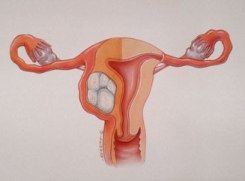Fibroids are the tumors made up of muscle cells and other tissues that develop in the walls of the uterus (womb).
The fibroids are also known as fibromyomas, leiomyomas or myomas.
Mostly, they are benign (non-cancerous), and do not cause symptoms.
It is also found that fibroids are present in one out of every four women of childbearing age.
It tends to disappear after the menopause.
Although the cause of fibroids is unknown, they are influenced by estrogen. The chances of having fibroids are high when estrogen levels are high (during a woman’s middle years) and when estrogen levels drop (after the menopause) they stop growing.
With the recent studies, according to US, it is found that the occurrence of fibroids is nine times more in black women than in white women. However, the reason behind this occurrence is unclear.
The chances of having fibroids are high in women who are over seventy kg. Even this is also due to higher levels of estrogen. They develop in women who have no children, probably with some genetic determinant, and in smokers (rarely).
Previously, it was thought that the possibility of having fibroids is high with the use of contraceptive pills, but that was when the pill contained higher levels of estrogen than it is today.
However, recent studies suggest that the combined pill with estrogen and progesterone hormones and the mini pill with progesterone only actually help prevent the growth of fibroids.
Fibroids are named according to where they develop in the uterus. The types include:
Intramural — These are the most common type that grows within the muscular wall of the uterus.
Subserous — This type usually develop in the outer side of the uterus wall and occasionally grow on stalks, called pedunculated fibroids. These fibroids can become very large.
Submucous — This type develops from the inner wall of the womb and can take up space inside the womb. Even, these can grow on stalks that can hang through the cervix.
Cervical — This type of fibroids grow in the wall of the cervix (neck of the uterus) and it is hard to take out without damaging the surrounding area.
The fibroids in the uterus can develop as single or in groups. Moreover, it can be of one type of fibroid or a number of different types.
As the cause of fibroids is unknown, you have no proper guidelines for preventing your fibroids. However, here are some useful instructions that can be followed to reduce your risk:
Exercise regularly and always keep checking your weight. This can help determine the estrogen levels in your body. Even Usage of combined pill can prevent fibroids growth by balancing hormone levels. But, talk to your doctor before using it.
Eat plenty of green vegetables and fruits, and avoid red meat. It is found that woman who takes little meat but a lot of green vegetables and fruit in her meal are less likely to develop fibroids.






